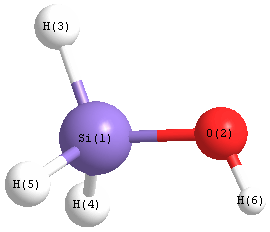Vibrational Frequencies calculated at B97D3/6-31G(2df,p)
| Mode Number |
Symmetry |
Frequency
(cm-1) |
Scaled Frequency
(cm-1) |
IR Intensities
(km mol-1) |
Raman Act
(Å4/u) |
Dep P |
Dep U |
|---|
| 1 |
A' |
3825 |
3825 |
65.31 |
78.83 |
0.27 |
0.42 |
| 2 |
A' |
2208 |
2208 |
106.01 |
97.50 |
0.23 |
0.37 |
| 3 |
A' |
2153 |
2153 |
101.65 |
145.19 |
0.08 |
0.15 |
| 4 |
A' |
993 |
993 |
154.18 |
4.23 |
0.67 |
0.80 |
| 5 |
A' |
957 |
957 |
96.37 |
9.57 |
0.74 |
0.85 |
| 6 |
A' |
913 |
913 |
54.94 |
10.42 |
0.68 |
0.81 |
| 7 |
A' |
824 |
824 |
124.19 |
7.79 |
0.18 |
0.30 |
| 8 |
A' |
682 |
682 |
58.37 |
4.50 |
0.64 |
0.78 |
| 9 |
A" |
2146 |
2146 |
181.27 |
57.56 |
0.75 |
0.86 |
| 10 |
A" |
931 |
931 |
66.90 |
12.59 |
0.75 |
0.86 |
| 11 |
A" |
701 |
701 |
56.22 |
8.35 |
0.75 |
0.86 |
| 12 |
A" |
211 |
211 |
93.75 |
1.62 |
0.75 |
0.86 |
Unscaled Zero Point Vibrational Energy (zpe) 8271.1 cm
-1
Scaled (by 1) Zero Point Vibrational Energy (zpe) 8271.1 cm
-1
See section
III.C.1 List or set vibrational scaling factors
to change the scale factors used here.
See section
III.C.2
Calculate a vibrational scaling factor for a given set of molecules
to determine the least squares best scaling factor.
Charges, Dipole, Quadrupole and Polarizability
Charges from optimized geometry at B97D3/6-31G(2df,p)
Charges (e)
| Number |
Element |
Mulliken |
CHELPG |
AIM |
ESP |
| 1 |
Si |
0.138 |
|
|
|
| 2 |
O |
-0.427 |
|
|
|
| 3 |
H |
0.009 |
|
|
|
| 4 |
H |
-0.013 |
|
|
|
| 5 |
H |
-0.013 |
|
|
|
| 6 |
H |
0.306 |
|
|
|
Electric dipole moments
Electric dipole components in Debye
(What's a Debye? See section
VII.A.3)
| |
x |
y |
z |
Total |
| |
-1.300 |
0.229 |
0.000 |
1.320 |
| CHELPG |
|
|
|
|
| AIM |
|
|
|
|
| ESP |
|
|
|
|
Electric Quadrupole moment
Quadrupole components in D Å
| Primitive |
|---|
| | x | y | z |
|---|
| x |
-19.625 |
-2.758 |
0.000 |
| y |
-2.758 |
-19.912 |
0.000 |
| z |
0.000 |
0.000 |
-21.532 |
|
| Traceless |
|---|
| | x | y | z |
|---|
| x |
1.098 |
-2.758 |
0.000 |
| y |
-2.758 |
0.666 |
0.000 |
| z |
0.000 |
0.000 |
-1.764 |
|
| Polar |
|---|
| 3z2-r2 | -3.527 |
|---|
| x2-y2 | 0.288 |
|---|
| xy | -2.758 |
|---|
| xz | 0.000 |
|---|
| yz | 0.000 |
|---|
|
Polarizabilities
Components of the polarizability tensor.
Units are
Å
3 (Angstrom cubed)
Change units.
| |
x |
y |
z |
| x |
4.131 |
-0.110 |
0.000 |
| y |
-0.110 |
4.145 |
0.000 |
| z |
0.000 |
0.000 |
3.956 |
<r2> (average value of r
2) Å
2
| <r2> |
39.153 |
| (<r2>)1/2 |
6.257 |
